Article and photos by Joe Sapia
Author’s note: The yard references are to my house in the section of Monroe between Helmetta and Jamesburg in South Middlesex County. My yard is in a Pine Barrens outlier on the Inner Coastal Plain, the soil is loamy, and my neighborhood is on the boundary of Gardening Zones 6b (cooler) and 7a (warmer). Afield references are to the Pine Barrens around Helmetta, unless otherwise noted.
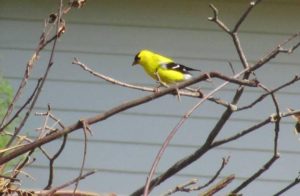
The New Jersey state bird, an Eastern goldfinch. Here, a male adult, distinguished by its bright colors.
THE NEW JERSEY STATE BIRD: I saw an adult male Eastern goldfinch, “Spinus tristis,” in the yard and he was in his bright mating colors of yellow, black and white. Females and juveniles are duller in color.
“SNOWBIRDS”: I may have seen the last of the dark-eyed juncos, “Junco hyemalis,” for the season about April 17. These “snowbirds” will head north, possibly as close as North Jersey or Pennsylvania, possibly as far as Canada, and not return until the fall. I normally see their return to my yard around Halloween.
OTHER BIRDS IN THE YARD: Robin, “Turdus migratorius,”; house finch, “Haemorhous mexicanus”; mourning dove, “Zenaida macroura”; cardinal, “Cardinalis cardinalis”; pigeon, probably “Columba livia”; tufted titmouse, “Baeolophus bicolor”; red-bellied woodpecker, “Melanerpes carolinus”; brown-headed cowbird, “Molothrus ater”; white-breasted nuthatch, “Sitta carolinensis”; and white-throated sparrow, “Zonotrichia albicollis.” The house finch and pigeon are non-native, but naturalized, species.
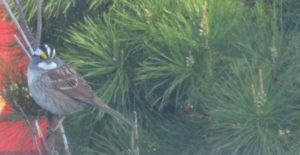
White-throated sparrow.
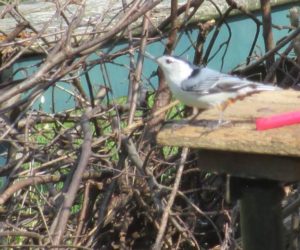
White-breasted nuthatch.
WHITE ROBIN: Hearing a report of a “white” robin in Cranbury Station on the boundary of Monroe and Cranbury, Middlesex County. Jean Wojaczyk describes it as having a pale orange chest and, basically, the rest being white.
BIRDBATHS: I got them filled at the normal backyard location and added another to the front yard. For years, I have used garbage can lids or shallow pans filled with water and placed directly on the ground.
HUMMINGBIRD FEEDER: Put it up April 16 to catch the “scout” hummingbirds, hoping to attract these early arrivals and, in turn, the others headed north. I have never been successful with hummingbirds, but I try again.
GREAT EGRET: Was able to photograph a great egret, “Ardea alba,” flying past my house.
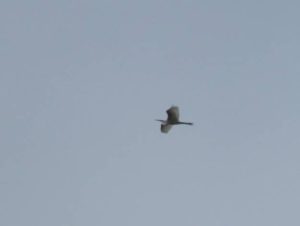
Great egret flying by my house.
PINE BARRENS AROUND HELMETTA: I walked the local Pines April 17 with Priscilla “Peppy” Bath, 85-years-old, of Hamilton Square, Mercer County. Peppy and I are longtime members of the Outdoor Club of South Jersey. Peppy and I observed quite a bit in our approximately 3-mile walk, including blooming trailing arbutus, “Epigaea repens,” whose flowers produce aeguably the nicest scent in the local pines; cinnamon fern, “Osmunda cinnamomea,” in its fiddlehead stage”; beautiful green skunk cabbage, “Symplocarpus foetidus”; inkberry, “Ilex glabra,” in berry; and eastern tent caterpillars, “Malacosoma americanum,” on a wild cherry tree, “Prunus serotina.”
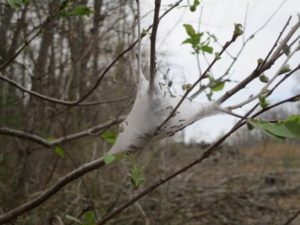
Eastern tent caterpillars on a wild cherry tree.
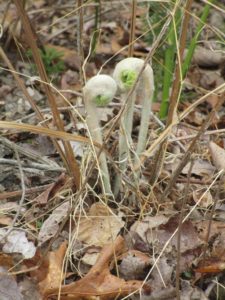
Cinnamon fern in its fiddlehead stage.
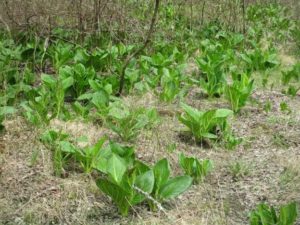
Skunk cabbage.
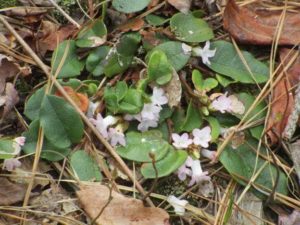
Trailing arbutus, “Epigaea repens,” – or “May pinks,” as Ma called them.
WANDERING BLACK BEARS: South Brunswick/Middlesex County, for example, had a sighting of a black bear, “Ursus americanus,” in recent days. So, just a heads up for the spring-summer roaming of bears. These wandering bears are likely to be young males, 80 to 100 pounds, chased off by older, larger males from traditional New Jersey “bear country” in the northwestern part of the state. So, the young males fan out, looking for their own territory.
CUTTING THE LAWN: I cut the lawn for the first time this season April 18 — and was aching that night.
WILD ONIONS: As I began cutting the lawn, I smelled onions – the wild ones growing in the lawn and now being mowed. I wish I liked onions more than I do, because there are plenty in my lawn.
SEEDING THE LAWN: As I maintain a no-fuss lawn and yearn for less and less lawn with more and more garden and wildlife patches, others want the magazine-looking lawn. I see these folks talking about seeding. Now is not the right time of year. Seed as early in September as possible and no later than mid-September is the advice I picked up a few years ago from the Rutgers University Cooperative Extension Service.
HOUSE PLANTS: I have about 30 house plants: devil’s ivy, spider plant, wandering Jew. On Easter Sunday, during my weekly-or-so watering, I was able to move some outside for watering, which is less messy, because it was so warm.
NIGHT SKY: Catch a look at the constellation Orion — easily identified by its belt of three stars before it disappears from view until the fall.
HUMAN-MADE OBJECTS IN SPACE: I always check out the night sky and, several days ago, I got a few-seconds view of a satellite or space junk. It was easy to pick out: moving across the sky, only a speck, not blinking. Not blinking because the light is the sun reflecting off it, rather than human lighting. So, as our sun-reflected view diminishes, the satellite disappears.
SUNRISE/SUNSET: For the week of April 23, Sunday, to April 29, Saturday, the sun will rise at about 6 a.m. to 6:10 a.m. and set at about 7:45 p.m. to 7:50 p.m.
WEATHER: Go to the National Weather Service forecasting station for the area, http://www.weather.gov/phi/.
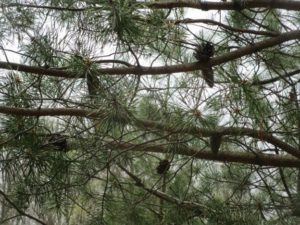
A Virginia pine, “Pinus virginiana,” in the Pine Barrens around Helmetta
Joe Sapia, 60, is a lifelong Monroe resident. He is a Pine Barrens naturalist and an organic vegetable-fruit gardener. He gardens the same backyard plot as did his Italian-American father, Joe Sr., and his Polish-immigrant, maternal grandmother, Annie Poznanski Onda. Both are inspirations for his food gardening. He draws inspiration on the local Pine Barrens from his mother, Sophie Onda Sapia, who lived her whole life in these Pines, and his Grandma Annie.
Article and photos by Joe Mish
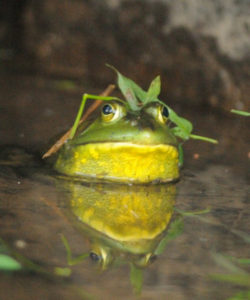
Areas which flood each spring are called vernal pools and attract several species of frogs. Each species produces a distinctive call, all in an effort to attract a mate. The orchestral performance this spring night was provided by spring peepers, pickerel frogs, green frogs and American toads. This green frog wears the equivalent of a lamp shade on his head after a night of froggy frolic.
The moon would not be full until the next night, though the difference could not be told without a lunar calendar. As the moon rose above the horizon it was shrouded in low clouds and tinted orange by the earth’s atmosphere. The moon appeared as if hiding behind a shear white veil, drawing more attention and holding a glance until it became a stare.
From the highpoint above the river, the first full view of the moon rising thru the thin white haze was screened by a loose weave of fine treetop branches. The delicate stems stood out in sharp contrast against the brilliant orb and moonlit clouds.
A tall cherry tree, growing out of a line of dark pines on a low ridge parallel to the river, perfectly balanced the moonlit scene with a staircase of blossoms turned luminous in the rising light.
A landscape painter could ask for no better inspiration than presented on this spring evening.
The overgrown path to the river was paved with fragments of white flowers from the blooming thornapple trees. The small round petals took on a glow in the rising moonlight to mark the trail, making it easier to follow.
A chipping sparrow, out later than it should have, hung onto a stem of tall amber broomsedge grass, as if it were a pole vaulter, caught in midair, hanging on to a pole at maximum flex.
The slow moonrise was reversed, as the trail to the river descended and hid the moon below the horizon.
Before the full moon reaches its zenith, visibility is lost in a temporary moment of deepening darkness, though a sense of night time vision may be provided by listening to the sounds of nature.
The call of geese from the river vibrated through the darkness to dominate the night. Their conversation was even and constant as they settled in for the night.
Their calls would pick up in response to late arriving flights validating a safe harbor below.
At night, geese dispense with circling and come right in with wings set and feet outstretched for touchdown. The sound of geese landing on water at night is a gentle extended, woosh, as their feet skim the water’s surface to slow the landing speed, followed by a barely perceptible splash.
The wind whistling through the primary feathers on birds wings, makes an odd creaking sound to betray their otherwise invisible night time approach. Straggling flocks of common mergansers and wood ducks landed parallel to the shoreline, mid river, and then dispersed to spend the night on the water in some eddy or quiet water below a fallen tree.
When the moon rose high enough to shed its gossamer haze to float above any earthbound obstruction, the moonlight intensified and now reflected on the river. Each ripple appearing as a silvery diamond. The ducks and geese became silhouettes as they drifted across a bejeweled stream of silvery light as viewed from opposite the light source.
Occasionally a call from an unidentified bird could be heard among the intermittent wood duck whistling and goose banter. The calls generated speculation, perhaps a black or yellow crowned night heron or just an irritated great blue heron.
The steady drone of spring peepers went nearly unnoticed as white noise, as it was separated from the sounds along the river by a good quarter mile. When attention was focused on the spring peepers which dominated the vernal pools, the solo calls of competing pickerel and green frogs could be heard. Focusing on sounds in the night, coming from opposite directions, was like simultaneously listening to two radio broadcasts; each source competing for attention.
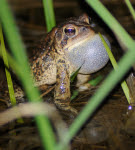
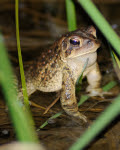
American toad
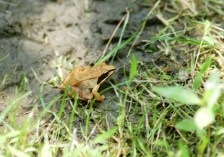
carpenter frog, alias wood frog
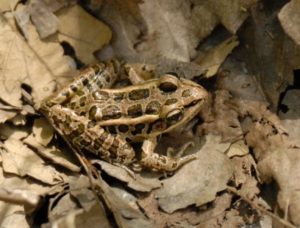
pickerel frog
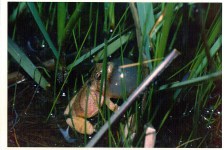
spring peeper/hyla crucifer
Author Joe Mish has been running wild in New Jersey since childhood when he found ways to escape his mother’s watchful eyes. He continues to trek the swamps, rivers and thickets seeking to share, with the residents and visitors, all of the state’s natural beauty hidden within full view. To read more of his writing and view more of his gorgeous photographs visit Winter Bear Rising, his wordpress blog. Joe’s series “Nature on the Raritan, Hidden in Plain View” runs monthly as part of the LRWP “Voices of the Watershed” series. Writing and photos used with permission from the author.
Article and photos by Joe Sapia
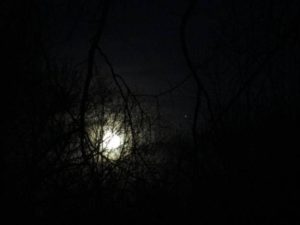
The Full Easter Moon rises over the Manalapan Brook floodplain in Monroe, Middlesex County, on the April 10-11, Monday-Tuesday, overnight. The white speck to the right of the moon is Jupiter.
Author’s note: The yard references are to my house in the section of Monroe between Helmetta and Jamesburg in South Middlesex County. My yard is in a Pine Barrens outlier on the Inner Coastal Plain, the soil is loamy, and my neighborhood is on the boundary of Gardening Zones 6b (cooler) and 7a (warmer).
FIRSTS OF THE SEASON: For the first time this season, I saw a bee, bat, and cabbage white butterfly – all on the same day, April 10. The bee was in my side yard, the cabbage white in my garden, and the bats, both flying over my yard and near woods edge at Manalapan Brook. (Also, it was the first day I heard my attic fan kick in.)

A cabbage white butterfly in my garden, near an oak leaf for a size comparison.
MULCHING TREES: Oh, no, mulch “volcanoes”! Those are the volcano-shaped mulch structures around tree trunks. Mulching is done for a variety of reasons, such as providing moisture and drainage, while serving as a buffer against yard equipment and giving the yard a neater look. But volcanoes are bad for the tree – they can lead to over-moisture and the introduction of disease. So, go for the “doughnut”: creating a doughnut-like circle around the tree, the inner circle having no contact with the tree or its roots, the outer circle 2 to 3 inches of mulch either to the end of the root ball or the tree’s drip line.
MA’S FLOWERING QUINCE: My family is the original owner of my house, going back to 1953. I was born in 1956 and never recall a time without Ma’s flowering quince bush. So, I figure the bush was planted soon after the family bought the property in ’53. This year, the flowering is not looking good, probably because of the warm weather inducing budding, followed by cold weather killing the buds.
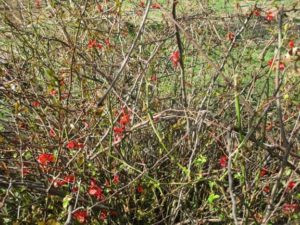
Ma’s flowering quince not looking too good this season, probably because the flowering was affected by the warm temperatures that prompting budding, followed by cold killing the buds.
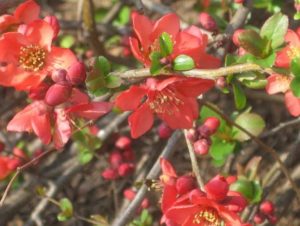
The flowering quince during a nicer bloom in spring, 2012.
FLOWERING AT “THE MASTERS” GOLF TOURNAMENT: The Masters Golf Tournament played annually in Augusta, Georgia, is known for its flowering beauty. This year, though, Augusta had a warm winter followed by cold spring days, prompting an early bloom followed by killing freezes. So, when the Masters was played April 6 to 9, the flowering was not that vibrant.
HELMETTA POND FISHING: Helmetta Pond is a typical Pine Barrens “tea water,” acidic body of water, here in the Spotswood Outlier of the Pines. Joey Slezak, my local go-to science person, fished the Pond April 12 and caught pickerel and largemouth bass.
BIRDS SINGING: Listen to the spring songs of birds, probably asserting territory or seeking mates. This week, I heard them as early as about 5:15 a.m., or more than an hour before sunrise.
SNORTING DEER: On the overnight of the full moon, I walked across the street to Manalapan Brook, spooking some deer. At least one gave out a few loud snorts, probably alerting other deer of my presence and maybe trying to spook me. The snort is sort of spooky, but something I get a kick out of, wildlife communicating because of me. Then, the deer bolted.
MA’S FLOWERS: Ma died at 81-years-old in 1995, but, come spring, her front yard daffodils and crocuses continue blooming.
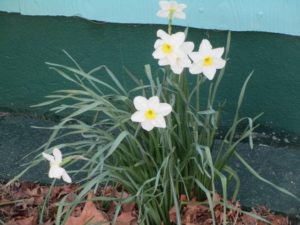
Ma’s daffodils, still blooming in the front yard, 22 years after Ma died.
MORE NATURE NEWS FROM THE JERSEY MIDLANDS: See the observations made by naturalist Bill Simmons, http://www.inaturalist.org/observations/wsimmons. Bill is the retired environmental coordinator for the Monmouth County Health Department. He also is at @BillSimmonsNJ on Twitter.com.
SUNRISE/SUNSET: For the week of April 16, Sunday, to April 22, Saturday, the sun will rise at about 6:07 to 6:15 a.m. and set at about 7:38 to 7:44 p.m.
WEATHER: Go to the National Weather Service forecasting station for the area, http://www.weather.gov/phi/.
— Joseph Sapia
2017, April 15, Easter Saturday,
Joe Sapia, 60, is a lifelong Monroe resident. He is a Pine Barrens naturalist and an organic vegetable-fruit gardener. He gardens the same backyard plot as did his Italian-American father, Joe Sr., and his Polish-immigrant, maternal grandmother, Annie Poznanski Onda. Both are inspirations for his food gardening. He draws inspiration on the local Pine Barrens from his mother, Sophie Onda Sapia, who lived her whole life in these Pines, and his Grandma Annie.
Article and Photos by Joe Sapia

Turning over the vegetable garden
Author’s note: The yard references are to my house in the section of Monroe between Helmetta and Jamesburg in South Middlesex County. My yard is in a Pine Barrens outlier on the Inner Coastal Plain, the soil is loamy, and my neighborhood is on the boundary of Gardening Zones 6b (cooler) and 7a (warmer).
MESSING UP PREPPING THE VEGETABLE GARDEN: To get a jump on the vegetable garden, I sowed inside early season plant seeds of lettuce, carrots, and peas. That was a mistake. When I was transitioning them to plant outside, I killed them. I should have waited and planted them directly into the garden. So, I had to regroup….
…PLANTING THE EARLY SEASON GARDEN: I bought new seeds – “Salad Bowl Green Heirloom Lettuce,” “Rainbow Blend Carrots,” and “Sugar Daddy Snap Peas,” all Lake Valley Seeds brand – and planted the early spring garden April 8.
NEXT UP AT THE GARDEN: I will plant the summer crops – sweet corn, tomatoes, cantaloupe, and cucumbers, along with zinnias for color and to attract pollinators – roughly May 20 (if the weather has been warm) to June 1 (if the weather has been cool).
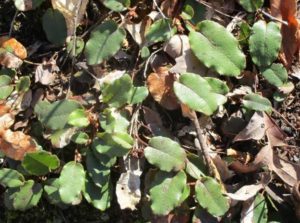
Unflowering trailing arbutus, or “May pink.”
FLOWERING IN THE WOODS: Swamp maples have their red tinge of buds, along with the budding of “May pinks” (trailing arbutus). I saw a report trailing arbutus has already flowered in the main Pine Barrens to the south, but have not seen any beyond budding in the Pine Barrens around Helmetta.
BIRDS SINGING SPRING SONGS: I am hearing the birds beginning their daily singing about 6 a.m. to 6:15 a.m., or about 15 to 40 minutes before sunrise. The birds presumably are singing to assert territory and to attract mates.
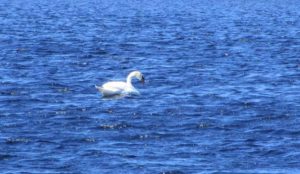
A beautiful, but invasive, mute swan at Helmetta Pond
“POND PIGS” AT HELMETTA POND: While beautiful, mute swans are a non-native bird that have been naturalized in America – and are disrupting the natural world around them. They are aggressive to humans and animals and deplete food supplies. There were brought to this country from Europe in the late 1800s and early 1900s.
LAST SNOW OF THE SEASON: Since the winter of 1995-1996, it has snowed as late as April 16 (April 9-10 for accumulating snow). Judging from the upcoming weather forecast, we probably had our last snow of the season, which was March 15.
OCCASIONAL LOUDNESS OF THE NEW JERSEY TURNPIKE: Wonder why the sound of the Turnpike is very loud at times, well beyond the quiet background noise? Probably because of warmer temperatures in the air compared with colder ones at the ground level.
GREEN WATERING OF THE GARDEN: Last year, I used a combination of drinking water from the house spigot and “gray” water (used bathing water). I got thinking about conserving house water – or even more conservation than I already do – and not putting soapy bath water into the garden. So, this year, 1. I am going to try using more accumulated rain water, making sure I keep the barrel covered when not in use so as not to promote mosquito breeding; 2. I am going to try to use available fresh water, perhaps from Manalapan Brook and a nearby swamp.; and 3., Conserve even more water at home. (In the 15 years since I have been taken over the family house, I have cut water usage by up to about 50 percent, the results of a bathroom renovation and conservation.
SUNRISE/SUNSET for April 2 to 8: Roughly about 6:20 to 6:30 Eastern Daylight Time for sunrise and about 7:30 to 7:35 for sunset.
VIEWING THE INTERNATIONAL SPACE STATION: The ISS may be visible Tuesday, April 11, 8:16 p.m. to 8:21 p.m., from north northwest to east; Friday, April 14, 8:53 p.m. to 8:56 p.m.; and Saturday, April 15, 8:02 p.m. to 8:06 p.m.
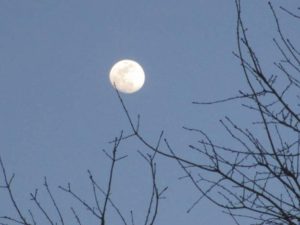
The near-full moon over Manalapan Brook in Monroe
NIGHT SKY: The Full Sprouting Grass Moon is on the Monday-Tueday, April 10-11, overnight. Also, see http://earthsky.org/tonight.
DROUGHT: With the recent rains, drought concerns may be lifted in the coming days by the state Department of Environmental Protection.
— Joseph Sapia
2017, April 9, Sunday,
Joe Sapia, 60, is a lifelong Monroe resident. He is a Pine Barrens naturalist and an organic vegetable-fruit gardener. He gardens the same backyard plot as did his Italian-American father, Joe Sr., and his Polish-immigrant, maternal grandmother, Annie Poznanski Onda. Both are inspirations for his food gardening. He draws inspiration on the local Pine Barrens from his mother, Sophie Onda Sapia, who lived her whole life in the local Pines, and his grandmother.
Article and photos by Joe Mish
RAINFALL: It rained about 2.5 inches in the New Brunswick-Trenton area at the end of last week. So, it will be interesting to see what this week’s drought maps say.
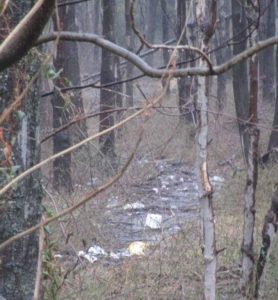
Garbage floating in a Monroe, Middlesex County, drainage ditch
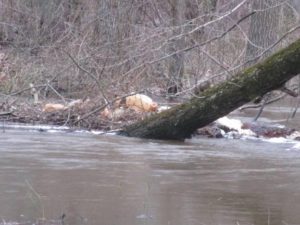
Garbage caught on a tree snag
in Manalapan Brook, Monroe, Middlesex County
NON-POINT SOURCE POLLUTION: During and after the week’s rains, the flow of non-point source pollution was obvious in our waterways. The cost-free way of dealing with it is, do not litter and do not leave stuff out in the yard, then it will not float into waterways.
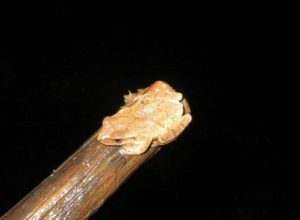
A spring peeper treefrog, found in the Manalapan Brook floodplain
FROGS: I walked into the swamp hardwood forest of the Manalapan Brook floodplain between Helmetta and Jamesburg early in the week. The sleigh bells-like sound of spring peeper treefrogs, “Pseudacris crucifer crucifer,” was obvious. I also heard monkey chattering-like sound of wood frogs, “Rana sylvatica.”
RASPBERRIES: I planted five bare-root Burpee seed company Caroline raspberry plants.
GARDEN ZONES: Depending on the source, the area is Garden Zone 6 (cooler) to Garden Zone 7 (warmer). That means our last frost generally is April 15 to 30; Our first frost is generally Oct. 11 to 20. Beyond that, I am playing it safe and sticking with Zone 6 for my Helmetta area, Middlesex County, home, although the area becoming a solid Zone 7 because of global warming is likely just around the corner.
OUTDOOR PLANTING FOR SUMMER VEGETABLES AND FRUITS: My rule of thumb is May 20 if it is a warm to normal and, if it is cooler, wait to June 1.
PREPARING PLANTS INDOOR: This year, though, I am trying something new, sowing plants indoors before the outside plant dates. So, I am experimenting with Kaleidoscope Blend Organic and Touchon carrots, Iceberg A lettuce, and Sugar Snap peas, all Burpee, which I began sowing about March 5. I added Rutgers tomatoes about March 25. I plan on sowing more tomatoes – Brandywine Red and Red Cherry, both Lake Valley brand – indoors in the next day or so.
HUMMINGBIRDS: Get the hummingbird feeders up by about April 15 to attract the early “scout” birds and they hopefully will lead later-arriving hummingbirds to the feeders.
NIGHT SKY: http://www.skyandtelescope.com/observing/sky-at-a-glance/this-weeks-sky-at-a-glance-march-31-april-8/.
SUNRISE/SUNSET: Approximate times are April 2, Sunday, 6:40 and 7:23 Eastern Daylight Time; April 3, Monday, 6:38 and 7:25; April 4, Tuesday, 6:36 and 7:26; April 5, Wednesday, 6:35 and 7:27; April 6, Thursday, 6:33 and 7:28[ April 7, Friday, 6:31 and 7:29; an April 8, Saturday, 6:30 and 7:30.
WEATHER: Local weather forecasts are available at http://www.weather.gov/phi/.

Carnegie Lake near the Kingston dam
on the boundary of Mercer, Middlesex, and Somerset counties
Joe Sapia, 60-years-old, grew up and lives in the Pine Barrens around Helmetta, where his family has resided for more than 100 years. He can be reached at Snufftin@aol.com or at P.O. Box 275, Helmetta, 08828.
Article and photo by Joe Mish
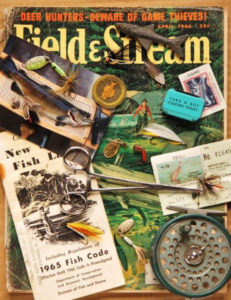
Field and Stream dreams come true on the South Branch of the Raritan. Opening day of the NJ trout season stirs memories as strong as a lifetime of Christmas morning and birthday surprises.
Right along with the anticipation of presents on Christmas morning, April and the opening day of fishing season both involved a dedicated countdown. For a month, each passing day was marked with a big X on the complimentary Esso service station calendar. It was understood, there would be no sleep on the eve of this once a year event.
Times have changed but tradition still lingers as many NJ anglers prepare for the opening of trout season in early April. One of the best places to live out a fishing fantasy is in Branchburg. As the name implies the township is bound for the most part by the North and South branches of the Raritan River, both heavily stocked with trout by the NJ Division of Fish and Wildlife.
Of course trout are not the only game in town. As the river flows from the mountains to the sea, fish can swim upstream as well as down. What that means is tiger muskies and hybrid bass can find their way downstream from Spruce Run as well as stripped bass, hickory and American shad can migrate upstream from the Atlantic Ocean. The state had been using an underwater camera to monitor quantity and species of fish in the area around the confluence of the Raritan and Millstone rivers, species you wouldn’t believe were observed. It was reported in a news article several years ago that trophy brown trout, walleyes, muskies, stripped bass, shad and several forage species were recorded. The beauty of fishing a river is you never know what you might catch.
While trout get the most press, the lower river is primarily a seasonal trout fishery with most angler activity occurring around opening day and subsequent stockings. It is considered to be ‘put and take’ fishing. There are holdover trout but you have to search for them. It is reported trout will travel distances to find suitable habitat with the water temperature being a prime factor. Each species has a preference for a specific temperature range so be sure to carry a thermometer if you want to become serious about your fishing.
The South Branch is also chock full of smallmouth bass which are a year around fish. Fish in the twenty-two inch range have been reported. Smallmouths in the twelve to fifteen inch range have a tendency to tailwalk on the surface of the water while their big brothers often stay deep and pull hard. My favorite lure for these ‘bronzebacks’ is a Panther Martin spinner with a small curly tailed grub on an ultralight fishing rod. Always have a hemostat or thumb forceps handy to remove the hook from any fish you wish to release.
Fishing methods and equipment span the spectrum of human imagination and most are effective on any given day. Expensive Orvis fly rods to lawn chairs and igloo coolers, garden worms to woolly buggers to Mepps spinners all take their share of fish. Fishing allows for as much science, superstition or tradition you might want to use in your piscatorial pursuits. There are even solunar tables which scientifically predict the best days to fish, however, everyone knows the best day to fish is whenever you get the chance.
So if your bumper sticker proclaims, “the worst day of fishing is better than the best day at work”, you already have your gear in ship shape condition and have started your countdown to the April 8th NJ trout season opener for 2017.
Author Joe Mish has been running wild in New Jersey since childhood when he found ways to escape his mother’s watchful eyes. He continues to trek the swamps, rivers and thickets seeking to share, with the residents and visitors, all of the state’s natural beauty hidden within full view. To read more of his writing and view more of his gorgeous photographs visit Winter Bear Rising, his wordpress blog. Joe’s series “Nature on the Raritan, Hidden in Plain View” runs monthly as part of the LRWP “Voices of the Watershed” series. Writing and photos used with permission from the author.
Article and photos by Joseph Sapia
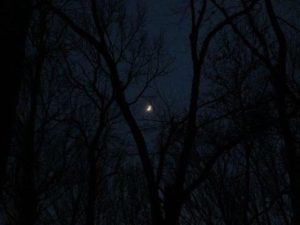
Above the Manalapan Brook floodplain, a crescent moon waxed toward December’s Full Long Nights Moon
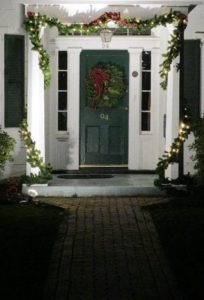
Christmastime in Fair Haven, Monmouth County
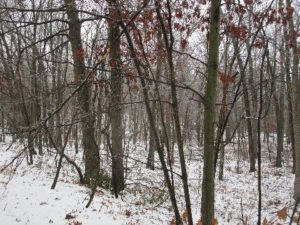
Snowfall of 1-1/2 inches December 17 in the Jamesburg Park Conservation Area, Middlesex County
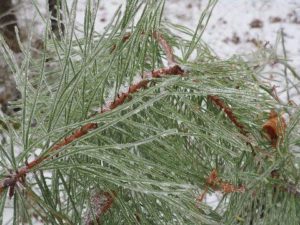
Ice builds up on the needles of a pitch pine, Pinus rigida, the common tree of the New Jersey Pine Barrens. Here, in the Jamesburg Park Conservation Area in the Pine Barrens around Helmetta.
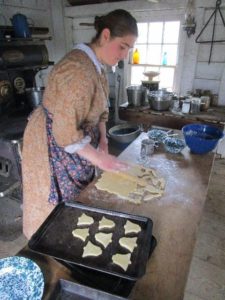
Christmastime at historic Longstreet Farm, the Monmouth County Park System’s living history farm, replicating the late 1800s in Holmdel. Here, baking cookies the old-fashioned way.
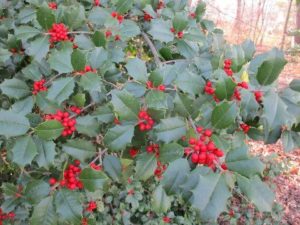
Holly in my neigbhorhood in Monroe, Middlesex County.
Joe Sapia, 60-years-old, grew up and lives in the Pine Barrens around Helmetta, where his family has resided for more than 100 years. He can be reached at Snufftin@aol.com or at P.O. Box 275, Helmetta, 08828.
Article and photo by Joe Mish
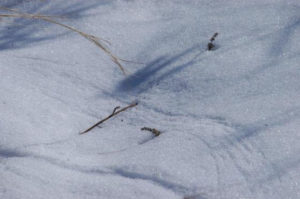
The hand of the wind uses the delicate grass to etch its thoughts in the snow. Nature’s secrets are whispered among the wooded hills and fields for all who pause to ‘listen’.
March is the month when winter puts its house in order to depart our latitude on its tour of the earth.
Remnants of left over winter wind, swept from dark, frozen nooks and crannies, are set free to blow themselves out in the twenty days leading to the arrival of spring.
The force of the wind breathes life into tree canopies and grasses as they dance and sway to the tune of the invisible but palpable energy. There is joy expressed when those, planted in place, unable to change location, experience rhythmic movement in perfect time.
A linear mass of silver maple trees, along the river’s edge, branches tipped with red velvet buds, sway in unison, as they execute a perfect ‘wave’, encouraged on by a burst of wind which leads the cheer.
Consider that the trees and tall meadow grass have evolved to take advantage of the wind. Dispersion of seed that still cling to stems and pods are sent aloft on a later flight to give the best chance for germination than seeds dispersed months earlier.
Trees benefit from the March wind as broken, insect infested branches are excised in a manner to suggest surgical intervention to remove a cancerous limb. The wind effectively prunes tree branches to allow sunlight to penetrate the canopy and promote new leaf growth; each leaf a new solar factory to boost the tree’s nutrient supply.
The wind has a wide range of expression that arises from deep internal turmoil. Perhaps the wind offended the gods in a prideful manner that justified eternal punishment. The gods therefore made the wind invisible to all the senses except for touch, and then only when the wind moves.
The wind constantly struggles with this blow to its vanity and does its best to make its presence known by channeling other elements.
Think about the wind and the scale of expression from hurricanes and tornadoes to a gentle whisper, where the wind uses a dried stem of grass or tree branch to etch its thoughts in the snow or the side of a wood building.
A spring breeze, carrying the scent of lavender blossoms, adds another dimension to the wind’s ‘visibility’ as the wind assumes the identity of the aroma. This is an expanded statement of expression; a loophole to get around the punishment imposed by the gods. This pleases the wind.
As the wind struggles to regain its physical identity and frustration builds, snow and ice are incorporated to flesh out the wind and give it a visible form.
Sometimes the desire to be seen is so fierce, the wind driven snow and ice makes the sense of sight useless, adding to the wind’s frustration, causing it to howl louder and blow harder.
The blustery wind, complement of March’s winter legacy, eventually subsides to become the gentle breeze of spring. The edge of winter passes and tempers the winds attitude to more gentle expressions of mood.
Author Joe Mish has been running wild in New Jersey since childhood when he found ways to escape his mother’s watchful eyes. He continues to trek the swamps, rivers and thickets seeking to share, with the residents and visitors, all of the state’s natural beauty hidden within full view. To read more of his writing and view more of his gorgeous photographs visit Winter Bear Rising, his wordpress blog. Joe’s series “Nature on the Raritan, Hidden in Plain View” runs monthly as part of the LRWP “Voices of the Watershed” series. Writing and photos used with permission from the author.
Article and photos by Joe Mish

A juvenile myrtle warbler searches the ice shrouded shoreline of the South Branch in late February
February is midwinter’s better half, given it is two days shorter than any other month and two days closer to spring, a virtual, ‘get out of winter free, card’. The significance of those two missing days provides a powerful psychological boost to soothe winter doldrums and seasonal affective disorder accumulating since December.
Although spring is the ‘finish line’ for surviving winter, the early days of spring are often indistinguishable from winter weather. This demonstrates that our characterization of the seasons is based more on legend than reality, especially when a lingering winter feels like an eternity.
Moving from impressionable feelings and missing days to more tangible evidence, February provides many visual clues that spring is around the corner. Its 28 days are a prelude or appetizer, stirring the emotions, building anticipation for the main event, the first day of spring.
To see visual clues we need light and light is what February delivers. In 28 short days we gain about an hour of day length, most evident to causal observers by noting the later time of sunset.
The increasing day length triggers a response in people and animals as we see the start of bird migration, courtship, flowers and tree buds.
Bird migration is one of the most colorful visual cues that winter has run its course. The milder the winter the earlier migration begins. Migration may be local, as with bluebirds or two thousand of miles away for many of the colorful warblers.
Late February usually marks the very beginnings of small bird migration north. Our rivers, streams coastlines and even interstate roadways provide linear pathways for migrating birds. The most colorful and plentiful are the myriad of warbler varieties. It is not unusual to see a bright flash of color darting along the riverside in late February despite shoreline ice and cold weather. A band of north bound travelers may find temporary shelter during a cold spell on south facing hillsides or in brush along steep river banks, protected from the wind and saturated with full sun.
Hawks are usually seen now in pairs as they bond prior to nesting. The owls hooting on cold winter nights and local bald eagles may well be incubating eggs.
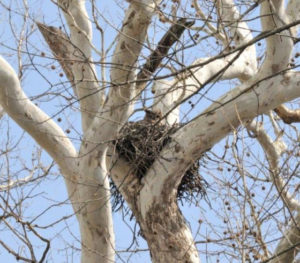
Great horned owl nesting in am old red tailed hawk nest
Muskrat, mink and fox are out and about in a courting mood. This is the time to scan fields for red fox roaming the countryside looking for mates. Love is definitely in the air.
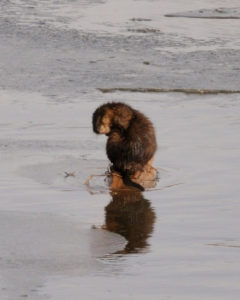
Muskrats are more often seen during their late winter early/ spring courting season
Male white-tailed deer have dropped their antlers and females are heavy with fawns as day length triggers hormonal changes to alter behavior and ensure best chances for winter survival. Now is a good time to walk the fields and woodlots to look for dropped antlers.
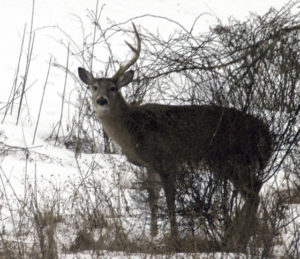
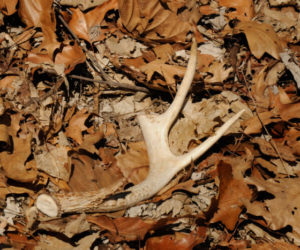
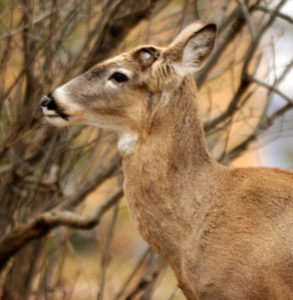
A buck has dropped one antler, the other will soon drop perhaps when it jumps a fence. A dropped antler charcterized by an irregular base. Antler buds after the antlers drop. Within a couple of months, the antlers will begin to sprout from these buds surrounded by viable tissue with a velvety appearance that readily bleeds if injured.

The first and most consistent sign of spring for me is the blooming of snowdrops, en masse on a hillside, near where I usually launch my canoe on the South Branch. As cold as it might be, the sight of those tiny white flowers gives me inspiration, fires my energy and issues a solemn promise of the return of spring.
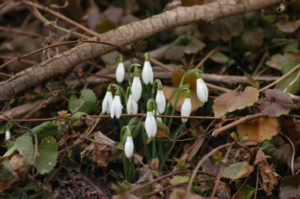
A patch of snow drops blooming midwinter heralds the return of spring
By February, the deep red leaf buds, on the trees that line the river, stand out against brown and gray interlaced branches. When viewed at a distance, the contrasting colors are enhanced as they take on a solid appearance as if created by long horizontal brush strokes in a painting.
A full moon will occur on February 11th to light up the night, as a compliment to the lengthening daylight, to make February a well lit marquee announcing next month’s arrival of spring.
Author Joe Mish has been running wild in New Jersey since childhood when he found ways to escape his mother’s watchful eyes. He continues to trek the swamps, rivers and thickets seeking to share, with the residents and visitors, all of the state’s natural beauty hidden within full view. To read more of his writing and view more of his gorgeous photographs visit Winter Bear Rising, his wordpress blog. Joe’s series “Nature on the Raritan, Hidden in Plain View” runs monthly as part of the LRWP “Voices of the Watershed” series. Writing and photos used with permission from the author.
Photos and Article by Joseph Sapia
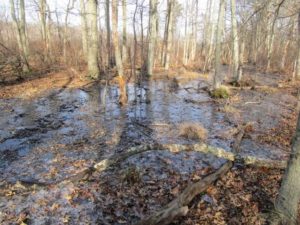
A pond at Szeliga’s Orchard
On this near-to-Christmas day, I was without my Jeep, which was in the shop for most of the day for routine, but time-consuming, maintenance. Without a vehicle, I was living life by foot – walking a mile or so to lunch at the old general store in Helmetta and picking up my mail from my third-generation Post Office box next-door. The walk was to be pragramtic, rather than playful, although I chose a route skirting the woods, instead of walking the Main Road directly from my neighborhood.
After 60 years of living and about 40 years as a journalist, I should know, Be ready for what is out there, unexpected or not. As a woodsman here in the Pine Barrens around Helmetta since old enough, I should know, A walk is not simply a walk.
So, I was glad I put my camera in my pocket.
Before I even left the neighborhood, I came upon a cluster of holly, thick with leaves and holding many berries. A Christmas treat – and my first photographs.
After about three blocks, I went afield, getting on the Pipeline, then onto the freight railroad tracks. Almost immediately on the tracks, I saw a dead mouse lying on a tie between the rails . A victim of a hawk or fox or some other cause of death? I do not know, but another photograph.
As I walked the tracks north, toward Helmetta, I noticed two species of pine: pitch, with its long, swirled needles in clusters of three, along with Virginia, with short, swirling needles in clusters of two. Their green contrasted nicely against the clear, blue sky.
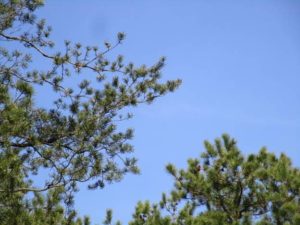
Virginia pine to the left, pitch pine to the right
After crossing Saw Mill Brook, I noticed a third pine in the old Szeliga’s Orchard: white, with supple needles in clusters of five. The species being easy to remember with its five needles, or W-H-I-T-E. It is not a native, here. This was probably an escape from nearby houses.
In the old orchard, I saw ground pine, or Lycopodium. Also, there was a nice little pond – I knew of the swamp, here, but did not remember this much ponding. And there was a fallen tree trunk, pecked by a woodpecker or woodpeckers.
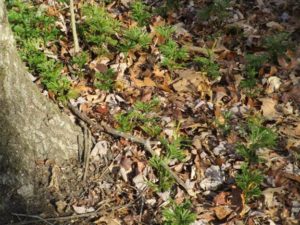
Ground pine at Szeliga’s Orchard
I got to the former worker homes of the George W. Helme Snuff Mill — which ceased production in 1993 and, this year, opened as apartments — and cut through the alley dividing them. After a visit to the Post Office and lunch at the store, I walked to Helmetta Pond.
There, I found a thin layer of ice along the shore – the temperature was now in the low 40s, but overnight it had got down to about 30. Canada geese sat in the pond on its other side by the woods. There, it was a mix of pines on the high ground, swamp hardwoods and Atlantic white cedar in the wetlands – and, it seemed, more and more invasive Phragmites reed grass.
On the way back, I took photos of ice in a ditch and Shekiro’s Pond, which had a cluster of punks, or cat-tails, dying off in the cold weather. Shekiro’s was fending off Phragmites nicely, unlike the Pond to the north and Cranberry Bog to the south.
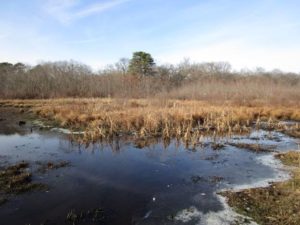
Shekiro’s Pond
At the Bog, I spooked a great blue heron, which took off slowly in flight. But not slowly enough for me to get a photograph. I did stop nearby, though, to shoot a stand of birch on the old Shekiro homestead.
On my way home, I was treated to a ConRail locomotive pulling two hopper cars toward Jamesburg. I snapped photos of the train, glad I had the camera with me over these few hours.
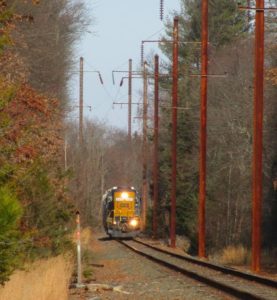
A ConRail train in Helmetta, heading toward Jamesburg
Joe Sapia, 60-years-old, grew up and lives in the Pine Barrens around Helmetta, where his family has resided for more than 100 years. He can be reached at Snufftin@aol.com or at P.O. Box 275, Helmetta, 08828.
Copyright 2016 by Joseph Sapia

















































